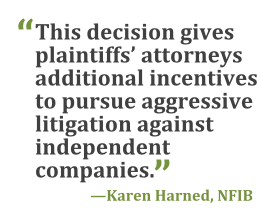The U.S. Supreme Court expanded the reach of a federal lawenacted in response to the 2001 Enron Corp. collapse, saying itprotects people who work for a public company's contractors,including law firms and auditors.
|The justices, voting 6-3, allowed whistle-blower claims by twoformer employees of a privately held company that providesinvestment advice and management services to the Fidelity mutualfunds.
|The case centered on protections that watchdog groups andPresident Barack Obama's administration say are important toprevent another Enron-like catastrophe.
|Congress was “aiming to encourage whistle-blowing by contractoremployees who suspect fraud involving the public companies withwhom they work,” Justice Ruth Bader Ginsburg said in her opinionfor the court. She said a ruling to the contrary would have put a“huge hole” in the law.
Enron, once the world's largest energy trader, collapsed afterusing off-books partnerships to hide billions of dollars in lossesand debt. The fraud also brought down Arthur Andersen, Enron'sauditing firm.
|The disputed law, the 2002 Sarbanes-Oxley Act, bars publiclytraded companies and their contractors and subcontractors fromdiscriminating against an “employee” who reports fraud or aviolation of securities regulations. The question was whether thatprovision allows retaliation lawsuits only by the employees of thepublic company, or by those of its contractors as well.
|The case was significant for the mutual fund industry. While thefunds themselves are publicly traded, they typically have few ifany employees, instead using privately held companies to conductday-to-day activities.
|Ginsburg said the court's interpretation of the law “avoidsinsulating the entire mutual fund industry” from the whistle-blowerprovision.
|'Fanciful Visions'
|Justices Sonia Sotomayor, Anthony Kennedy, and Samuel Alitodissented. Sotomayor said the majority had given the provision a“stunning reach,” authorizing lawsuits by babysitters and cleaningpeople over fraud unrelated to corporate governance.
|“If, for example, a nanny is discharged after expressing aconcern to his employer that the employer's teenage son may beparticipating in some Internet fraud,” the nanny could sue,Sotomayor said.
|Ginsburg said the dissenters were “indulging in fanciful visionsof whistle-blowing babysitters and the like.” She said there was noindication that anyone had sued under the provision without aconnection to shareholder fraud.
||The suing employees, Jackie Hosang Lawson and Jonathan M. Zang,worked for units of privately held FMR LLC. The units provideinvestment advice and management services to publicly tradedFidelity mutual funds.
|The workers say they lost their jobs after reporting fraud.Lawson complained that expenses were being inflated and,ultimately, passed on to fund shareholders. Zang contended that aFidelity statement filed with the Securities and ExchangeCommission (SEC) misrepresented how portfolio managers werecompensated.
|FMR denies the allegations and says both employees hadperformance problems. Zang was fired in 2005 and Lawson resigned in2007.
|“We believe that the allegations were unfounded when they weremade and they continue to be unfounded today,” said VincentLoporchio, a spokesman for the company. He said Fidelity “has longoffered employees a number of channels to report potential abuses,”including an anonymous telephone tip line.
|Appeals Court Reversal
|FMR argued that the reference to contractors and subcontractorsin the disputed provision applies only to a “workout firm” broughtin to wind down the affairs of a bankrupt company. The companypointed to the movie “Up in the Air,” in which George Clooneyportrays an “ax-wielding specialist” brought in to fire people.
|The company also said Congress addressed accounting firms andlaw firms in a different part of the 2002 statute, letting twofederal agencies issue regulations to protect those workers. Theagencies haven't issued any such rules.
|The decision reversed a federal appeals court, which had ruledthat Lawson and Zang couldn't invoke Sarbanes-Oxley because theydidn't work for publicly traded companies.
|“The Supreme Court closed a potentially devastating loophole incorporate whistle-blower protection,” said Stephen M. Kohn,executive director of the National Whistleblower Center, whichbacked the workers in the case.
|Small-business advocates said the ruling would prove costly.
|“The court is downplaying the reality that this decision givesplaintiffs' attorneys additional incentives to pursue aggressivelitigation against independent companies,” said Karen Harned,executive director of the National Federation of IndependentBusiness (NFIB) Small Business Legal Center.
|The case is Lawson v. FMR LLC, 12-3.
|Copyright 2018 Bloomberg. All rightsreserved. This material may not be published, broadcast, rewritten,or redistributed.
Complete your profile to continue reading and get FREE access to Treasury & Risk, part of your ALM digital membership.
Your access to unlimited Treasury & Risk content isn’t changing.
Once you are an ALM digital member, you’ll receive:
- Critical Treasury & Risk information including in-depth analysis of treasury and finance best practices, case studies with corporate innovators, informative newsletters, educational webcasts and videos, and resources from industry leaders.
- Exclusive discounts on ALM and Treasury & Risk events.
- Access to other award-winning ALM websites including PropertyCasualty360.com and Law.com.
*May exclude premium content
Already have an account? Sign In
© 2024 ALM Global, LLC, All Rights Reserved. Request academic re-use from www.copyright.com. All other uses, submit a request to [email protected]. For more information visit Asset & Logo Licensing.







